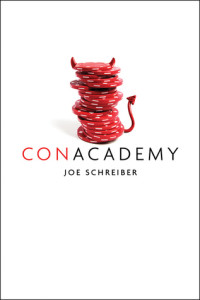This book is on the 2016 Lone Star List. This list is one of a few places I start when looking for a new YA or middle level book to read. Plus, Sherry and I are working on taking another Battle of the Books team to next year’s competition!
Why I Finished It:
This book never stopped. Sometimes I had to put it down because it didn’t ever slow. From the first page to the last, something was happening. Every now and then I put it down to catch up and slow my mind, but quickly came back. There were some interesting twists with exciting characters. The main character, Will, has been raised from a young boy to be a con artist. His whole life has been about pulling off another con. Once at his new school, preparing for yet another con, he meets a girl with a similar story. From here, the book starts racing you through the lives of these two con artists and how their lives will collide and battle each other.
Who I Would Give It To:
This book should be on secondary level bookshelves for sure. Those who like adventure and mystery will definitely enjoy this read. It’s even conducive to less motivated readers since there is hardly a down point in the book.
Integration Ideas:
Theme
A huge part of this book is about Will “finding himself” and discovering his identity. He is struggling to deal with how he was raised and what he’s always done with what he feels is morally correct. He is challenging authority and what has always been status quo. The theme is really solidified when Gatsby tells Will at the end (p. 234) that everybody makes mistakes, it’s what you do afterwards that matters.
Vocabulary
Teaching vocabulary is always difficult. As I’m reading the book, I try to think which words will give students a hard time and of those words which ones will they need to know to understand the story and characters and which ones would I like students to know, because they can use the word in their own writing. These are the words I will ultimately teach. This does not mean that the students will be writing the words out multiple times or mindlessly copying the definition. Students will interact with the words. They will integrate reading, writing, speaking, and listening into the learning. If students use all four literary senses they will have a better chance at “owning” the word.
- diversifying p. 5
- sycophants p. 46
- futility p. 58
- ostensible p. 67
- emanating p. 103
- repertoire p. 104
- vindictive p. 121
- indiscriminately p. 135
- puritanical p. 138
- insurmountable p. 157
- incompetent p. 163
- privation p. 167
- delusional p. 172
- indignity p. 172
- apoplectic p. 174
- resonant p. 175
- grifter p. 198
- altruism p. 204
- incarnate p. 222
- incredulity p. 224
Visualization and Descriptive Writing
One of my favorite parts of this read was the powerful visualization the author provided. I’m not an overly mushy person and I have little time for books that spend pages setting a scene, but Schreiber created a vivid scene in short paragraphs. One example: “And before I can say anything, she disappears into the stacks, moving through the deep jungle of the Dewey decimal system with all the confidence and authority of a lioness” (61). When explaining visual images with the students, I make sure they are aware of their five senses. After reading this sentence aloud, students can draw, discuss, or write how this ignited their sight, sound, smell, touch, and taste. Students enjoy acting out the scene. Practice changing some of the words, the simile, or leaving it out all together. This will show students how powerful exact words are and how simile’s paint a picture in the readers mind.
Don’t stop with this reading strategy! Help students see how they can write their own description in their writing. Choose scenarios or have students work in groups and assign random moments. Then have them write a quick description that creates a vivid picture for the reader. Some examples might be, walking into a surprise party, sitting alone at lunch, ten seconds left on the clock and you’re down by two points, etc. Once students have had time practicing writing descriptions, have them try to fix a moment in their own writing.
Other places in the book with strong description:
- Paragraph 3, p. 64
- Paragraph 2, p. 76
- Paragraph 2, p. 109
- Paragraph 2, p. 112
- Paragraph 2, p. 117
- Paragraph 7, p. 135
- Paragraph 7, p. 151
- Paragraph 1, p. 168
- Paragraph 2, p. 189
How do you teach visualization?







I found this very usefull I used it for a last minute project Thank you so Much!!!
We’re so glad it was helpful.